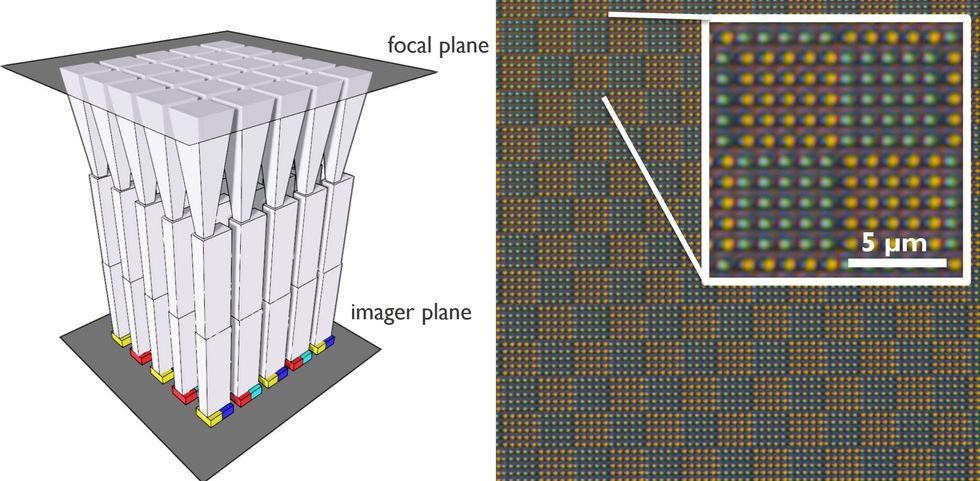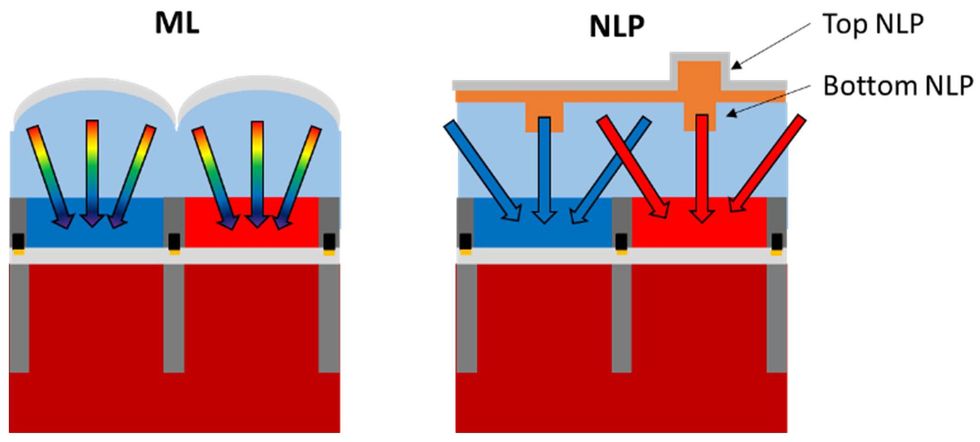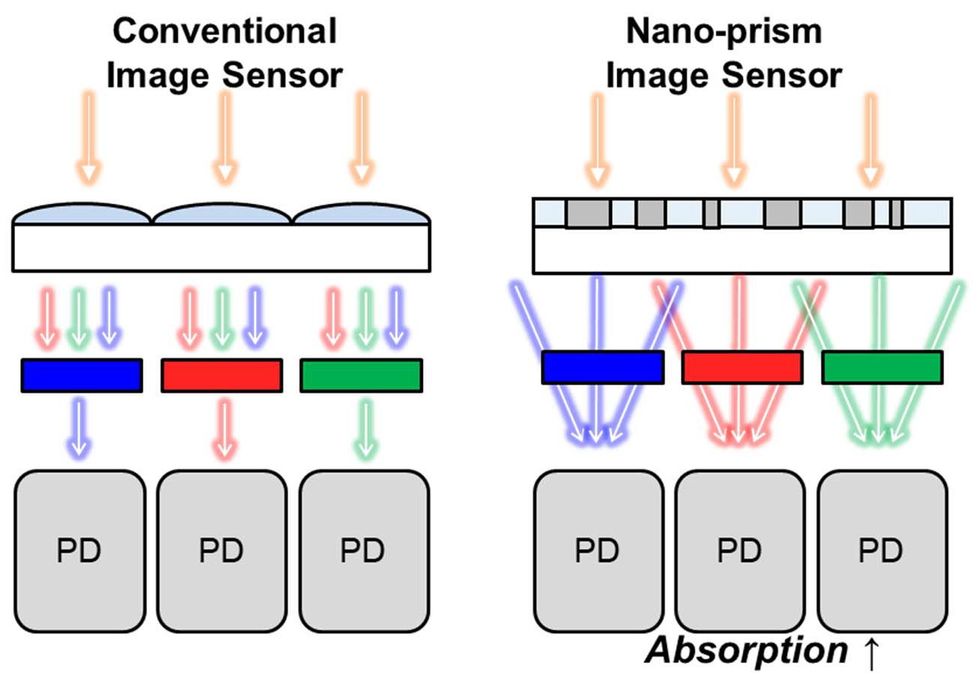The standard of a digital camera is usually restricted by its measurement and skill to let in numerous mild. In smaller cameras, lenses may also help enhance the picture high quality to an extent, however new approaches are as an alternative trying to enhance cameras by modifying the sensors that convert rays of sunshine into electrical alerts.
Three applied sciences offered on the 2023 IEEE Worldwide Electron Gadget Assembly (IEDM) promise to enhance the efficiency of CMOS picture sensors by integrating buildings instantly into the sensors to steer mild in response to its wavelength towards completely different shade pixels. This will increase the quantity of sunshine every pixel receives whereas sustaining a small pixel measurement.
“What you previously achieved solely by complicated system integration is now accomplished by wafer-level processes,” says session chair Andreas Mai, professor at Technical College of Utilized Sciences Wildau in Wildau, Germany. In smartphones, for instance, this type of integration might assist cut back the peak of the digital camera lens.
At IEDM, researchers from Imec, VisEra, and Samsung reported the invention of three applied sciences to enhance scaled-down picture sensors. Two of those use nano-scale metasurfaces, particularly prisms and pillars, to enhance CMOS sensitivity. The third squeezes mild by means of a shade splitter to type them into completely different shade pixels. “Often, you may solely obtain this by including extra parts or lenses on high of the picture sensors,” Mai says.
Coloration splitters tune to the human eye

Utilizing shade splitters, a picture sensor can improve its total sensitivity by having mild acceptable to every sensor channeled on to it.
imec
Researchers from Imec—based mostly in Leuven, Belgium—offered shade splitting expertise. As a substitute of utilizing shade filters, which soak up a number of the incoming mild, the colour splitter kinds mild of various colours to particular pixels. Sometimes, shade splitters work by way of diffraction, however the Imec design takes a unique method, permitting for a greater signal-to-noise ratio and determination.
The colour splitter first takes in mild on the focal airplane and focuses the sunshine by passing it by means of funnel-shaped tapers, explains Imec’s scientific director Jan Genoe, who offered the analysis at IEDM. The sunshine then passes by means of a vertical waveguide, which restricts the best way the sunshine propagates and creates wavelength-dependent patterns; so completely different wavelengths of sunshine land on completely different pixels on the detector.
The system is designed to be used in small imagers, reminiscent of smartphone cameras, and tuned by way of the waveguide’s dimensions to match the colour sensitivity of the human eye. “We wish to have a digital camera that offers one of the best shade presentation for human eyes,” Genoe says. The system offered exhibits a 95 p.c match—even higher than many high-end cameras.
Nano-light pillars convey low-light photographs into focus

“Nano-pillars” are a light-weight channeling type of a metasurface that, a little bit like Imec’s shade splitter, additionally direct particular wavelengths of sunshine to the detector pixels finest suited to obtain the sunshine.
VisEra Applied sciences
For one more method to directing mild to particular shade pixels, VisEra Applied sciences—a subsidiary of the Hsinchu, Taiwan-based TSMC—offered a sensor with buildings referred to as nano-light pillars. Like imec’s shade splitter, the buildings, referred to as a metasurface, reroute mild of various wavelengths to successfully growing the realm that receives every shade of sunshine. That is significantly helpful in low-light circumstances, says Chun-Yuan (Robert) Wang, part supervisor of optics and metrology improvement at VisEra Tech.
The researchers suggest the nano-light pillars as a alternative for standard micro-lenses. With micro-lenses, the light-receiving space is restricted to the bodily dimension of the pixels, and a few mild is all the time misplaced within the pixel’s shade filter. Two layers of fastidiously organized pillars constructed into VisEra’s system can collect mild from neighboring pixels by means of refraction: Inexperienced mild heading for a inexperienced pixel for instance, passes straight by means of the pillar. In the meantime, neighboring pillars are designed with completely different densities in order that they refract inexperienced mild, sending it to the inexperienced pixel.
Though there are different strategies to enhance imaging in low-light circumstances, these have drawbacks, says Wang. With the metasurface system, “you wouldn’t must resort to utilizing excessive [sensitivity] settings, which introduce noise, or gradual shutter speeds, which trigger picture blur, to compensate for the dearth of sunshine,” Wang says. The place the VisEra system does fall quick is in its response to mild that is available in at an angle due to discontinuities within the metasurface. Wang says he and his colleagues are actually researching options.
Nano-prisms view nicely at an angle

Samsung’s new nano-prism picture has a sensitivity to mild sources at extra indirect angles in comparison with some standard pixel tech at the moment.
Samsung
Just like the nano-light pillar buildings, nano-prisms—one other metasurface construction—additionally route completely different colours of sunshine to completely different pixels. Samsung’s nano-prisms use diffraction, fairly than refraction, to bend the angle of incoming mild. Moreover, whereas sensitivity to mild at indirect angles is a limitation of VisEra’s pillars, Samsung’s nano-prisms are particularly designed with the sort of mild in thoughts. In comparison with standard microlenses, they provide a large discipline of view and higher sensitivity.
By altering the sample of the nano-prism design, the researchers may tweak the spectral response, a measure of the present output by the detector in comparison with the incident energy. Often, this relies on the fabric of the colour filter, however nano-prisms can modify the spectral response with out having to alter the colour filter supplies.

